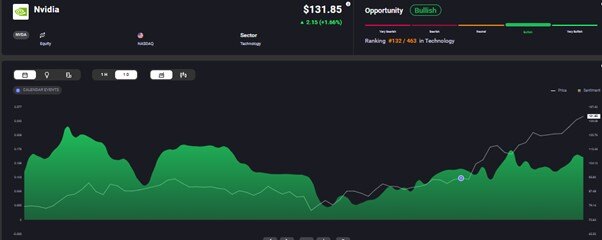Remember AskJeeves? At the turn of the Millennium, we’d use this to search for answers to questions like: What’s a comet? Then came Google and found its way to every part of our lives, from deciding on the hotel to book for our workcation and buying groceries to learning a new skill and planning meetings. What Google did to the Internet, Nvidia is doing for the AI space.
What we can give Intel credit for is that it saw this coming. In an interview with CRN in 2021, Intel’s then new CEO Pat Gelsinger said the company aims to become “ecosystem friendly.” Referring to the AI disruption in the datacentre space, Gelsinger had said that Intel’s products would put pressure on “an uncontested Nvidia.” Three years later, Intel is still trying to catch up.
The Nvidia-Intel Gap
The proof of the pudding is in the quarterly results. Intel reported first-quarter revenues of $12.72 billion, missing the cautious consensus estimate of $12.78 billion, with adjusted earnings of 18 cents per share, slightly ahead of market expectations. For the current quarter, management projected revenues of $13 billion at the midpoint, short of Street expectations, which took its shares lower by 8% in extended trading.
Then came Nvidia’s results for the same quarter. The company reported more than double the revenues of Intel. At $26.04 billion, the figure surpassed consensus of $24.65 billion. Nvidia’s adjusted earnings of $6.12 per share handsomely beat the Street’s $5.59 expectations. For the current quarter, management guided to revenues of $28 billion, exceeding estimates of $26.61 billion. The stock surged past $1,000. The company announced a 10:1 stock split.
The Market Share Gap
Nvidia wears the crown in AI, with a more than 90% market share in datacentre GPUs and over 80% share in the market for AI processors.

Intel is giving Nvidia some competition, but that’s only in AI chips. Intel is still trying to position its GPUs as viable alternatives for Nvidia’s H100. The company has priced its Gaudi 2 and Gaudi 3 AI chips much lower than that of Nvidia’s H100 chips. Yes, Nvidia takes that seriously. It’s already working to launch its more sophisticated H200. But let’s not read too much into that. It’s not even Nvidia’s gameplan anymore.
What’s Nvidia Doing Differently?
Your laptop may still have a sticker saying Intel Inside, telling you that it’s running on an Intel processor. That’s phenomenal. But Nvidia had bigger dreams. The company is more than a chipmaker. It has built a comprehensive and integrated stack of chips, systems, software and services for datacentres as well as cloud and edge computing and edge computing.
Kudos to CUDA
What Intel and even Advanced Micro Devices need to understand is that the Nvidia’s gameplan is CUDA, its proprietary computing platform and software stack that helps developers harness the power of the company’s GPU accelerators to speed up their machine learning workloads.
Companies with AI aspirations will be married to Nvidia just the way they are to the Google ecosystem to streamline work.
Nvidia’s sales have exploded with tech behemoths like Google, Microsoft, Meta Platforms, and Amazon purchasing billions of dollars of its GPUs for developing and deploying their AI applications.
Intel is Just Not Firing on All Cylinders
While grabbing the lion’s share of the processor market for personal computers, Intel somehow managed to miss the mobile revolution. UK-based Arm Holdings has grabbed the market for chipsets for premium smartphones. In fact, Apple ended its 15-year partnership with Intel in 2020 and moved to Arm’s chips for its computers too.
Their Stock Performance Says It All
Shares of Nvidia have been on an uptrend. The stock has gained more than 170% year to date and added over 200% in the past year to become the third-largest US company behind only Apple and Microsoft. In contrast, Intel’s stock has lost 16% over the past year and a whopping 36% so far in 2024.
Does this mean Nvidia’s stock is overvalued, while Intel’s shares provide a buying opportunity? The market sentiment suggests otherwise. The sentiment for Nvidia is still bullish and that for Intel is neutral, as per Acuity’s AssetIQ widget.


Wall Street analysts echo this sentiment. A majority of analysts covering Nvidia have a Buy rating, while most covering Intel have a Hold rating.
Intel needs to wake up and smell the coffee. The company’s alternative to CUDA, the oneAPI framework, has extremely low adoption. Intel needs to focus on making its tooling far more mature. If intel hopes to ride the AI wave, it needs to invest heavily into providing greater support for AI technologies. Else, it will continue facing heat not just from Nvidia, but also from the likes of Arm and TSMC (Taiwan Semiconductor Manufacturing Company).
Acuity’s tech analyses an array of market insights to generate trading ideas and gauge market volatility. Other Acuity Trading products include NewsIQ, AnalysisIQ, AssetIQ, the Acuity Corporate Calendar, and AI-Driven Economic Calendar, which have earned Acuity Trading the title of ‘Best Specialist Data Provider’ at the Technical Analyst (TA) Awards, ‘#1 Sentiment Analysis Provider 2024' by Forex Brokers and many shortlisted nominations across the fintech industry. For more on the unparalleled edge that Acuity’s data-driven research provides, explore further resources and solutions at acuitytrading.com.
Equities


